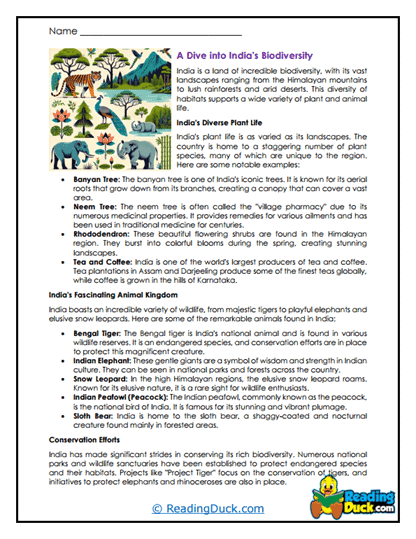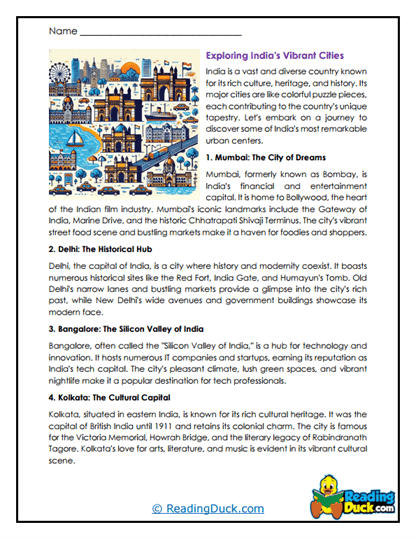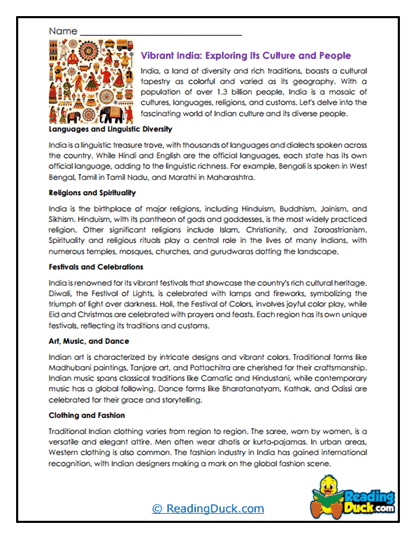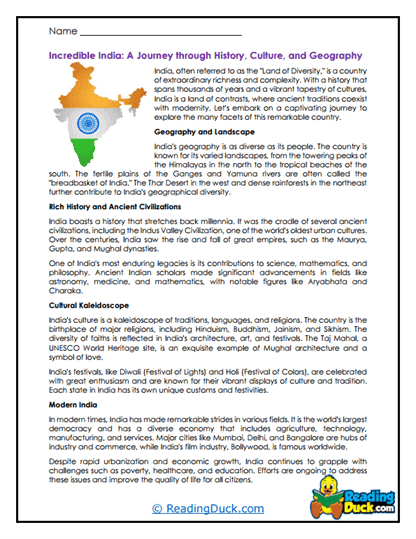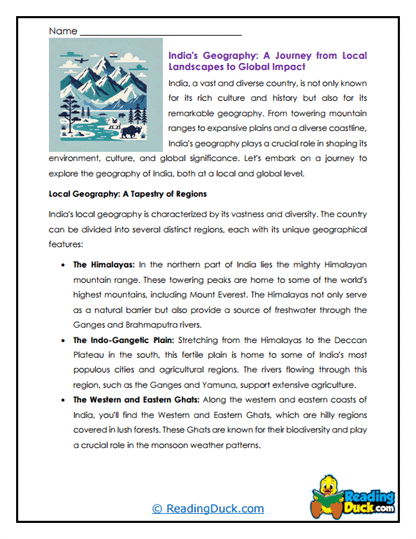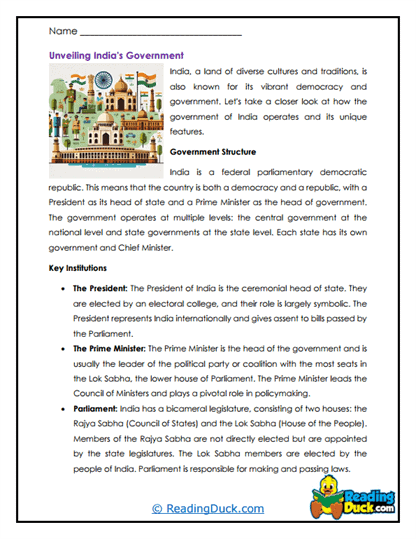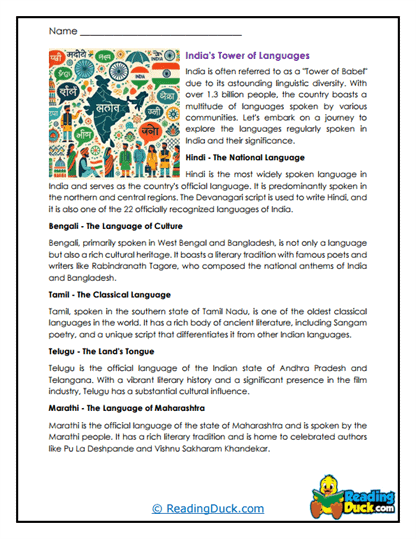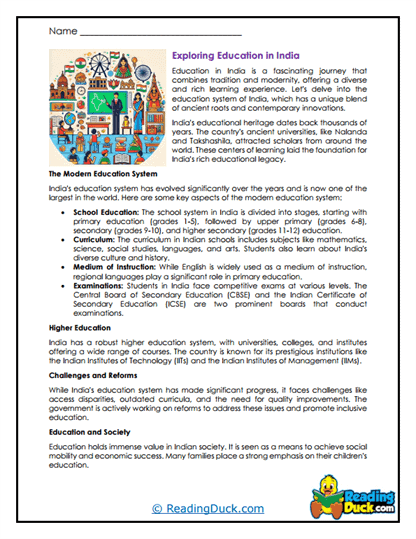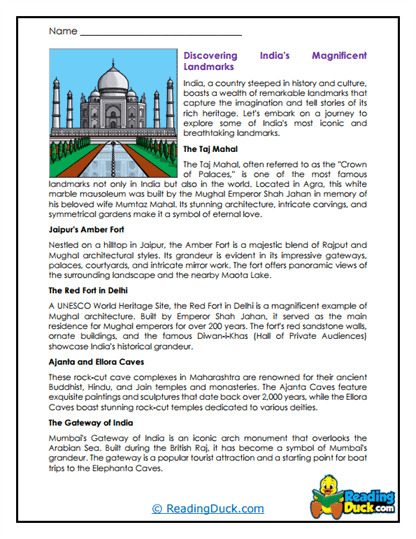India Worksheets
About Our India Worksheets
Our collection of India worksheets provides an in-depth and engaging exploration of one of the world's most diverse and historically rich countries. These worksheets, which fall under the category of Social Studies: World History, help students delve into various aspects of India, from its vibrant culture and long history to its vast geography and significant global influence. Each worksheet set is thoughtfully designed to reinforce key concepts and encourage critical thinking through a variety of question formats and visually engaging content.
Each worksheet set includes:
- Multiple Choice Questions: These questions assess students' understanding of the reading passage by offering several answer options, reinforcing essential facts and concepts about India’s history, culture, and geography.
- Short Answer Questions: In this section, students are encouraged to write their own answers based on the reading passage. This format allows students to express their understanding in their own words, deepening their comprehension of the material.
- Open-Ended Questions: These questions prompt students to provide personal input, opinions, or reflections related to the reading material. This format encourages students to connect the topic of India to their own experiences and broader understanding of world history.
An answer key is provided for every question sheet, making it easy for teachers and parents to review and assess students' work. All worksheets are available as PDF files, which can be easily viewed electronically, downloaded, and printed out for use in classrooms or homeschool settings.
Exploring India: A Journey Through History, Culture, and Geography
India is a country with a profound and complex history, diverse cultures, and a rich tapestry of landscapes. When introducing students to India, it's essential to cover its historical evolution, its vibrant culture, and its geographical significance. By exploring these aspects, students can gain a deeper understanding of how India has developed into the diverse and influential nation it is today.
Historical Overview
- Ancient and Classical India
- Early Civilizations: India’s history dates back thousands of years to one of the world’s earliest urban cultures, the Indus Valley Civilization, which flourished around 2500 BCE. The cities of Harappa and Mohenjo-Daro are famous for their advanced urban planning, including grid patterns and sophisticated drainage systems. The Vedic period followed, during which the foundations of Hinduism were established.
- Maurya and Gupta Empires: The Maurya Empire (322–185 BCE), under Emperor Ashoka, was one of the largest empires in ancient India and is known for its promotion of Buddhism. The Gupta Empire (320–550 CE) is often referred to as the "Golden Age" of India due to significant advancements in science, mathematics, astronomy, literature, and art.
- Medieval and Colonial India
- The Mughal Empire: The Mughal Empire (1526–1857) was a powerful and culturally rich dynasty that controlled much of India. The Mughals are known for their contributions to art, architecture, and culture, with landmarks like the Taj Mahal symbolizing their legacy. This period also saw the blending of Persian, Indian, and Islamic traditions, which greatly influenced Indian society.
- British Colonial Rule: India came under British control in the 18th century, leading to significant changes in its social, economic, and political structures. The British East India Company initially dominated trade, but after the Revolt of 1857, the British Crown took direct control. The struggle for independence, led by figures like Mahatma Gandhi, ultimately resulted in India gaining independence in 1947.
Culture, Geography, and Government
- Cultural Diversity
- Languages and Religions: India is one of the most linguistically diverse countries in the world, with 22 officially recognized languages and hundreds of dialects. Hindi and English are the most widely spoken. India is also a land of religious diversity, being the birthplace of major religions such as Hinduism, Buddhism, Jainism, and Sikhism. Additionally, it has a significant population of Muslims, Christians, and other religious communities.
- Festivals and Traditions: India is renowned for its vibrant festivals, which are deeply rooted in its cultural and religious traditions. Diwali, the Festival of Lights, is celebrated across the country and symbolizes the victory of light over darkness. Holi, the Festival of Colors, is another popular celebration, marking the arrival of spring. Each region of India has its own unique traditions, contributing to the country’s rich cultural mosaic.
- Geography and Natural Wonders
- Diverse Landscapes: India’s geography is incredibly diverse, ranging from the towering Himalayas in the north to the tropical beaches of the south. The country is home to vast deserts, lush forests, fertile plains, and mighty rivers like the Ganges and Yamuna, which hold significant religious and cultural importance. The Western Ghats and the Sundarbans are UNESCO World Heritage Sites that showcase India’s rich biodiversity.
- Monuments and Heritage Sites: India boasts a wealth of historical monuments and UNESCO World Heritage Sites. The Taj Mahal, a symbol of love and an architectural masterpiece, is one of the most visited landmarks in the world. Other significant sites include the ancient temples of Khajuraho, the forts of Rajasthan, and the Ajanta and Ellora caves, which are renowned for their rock-cut architecture and intricate carvings.
- Government and Economy
- Democratic Republic: India is the world’s largest democracy, with a parliamentary system of government. It has a President as the head of state and a Prime Minister as the head of government. The country is divided into 28 states and 8 Union territories, each with its own government. Since gaining independence, India has built a strong democratic tradition, holding regular elections and upholding the rule of law.
- Economic Growth: India has one of the fastest-growing economies in the world, driven by sectors such as information technology, manufacturing, and agriculture. The country is also a major player in global trade, with a rapidly expanding middle class and a young, dynamic population. However, India faces challenges such as poverty, infrastructure development, and environmental sustainability, which are key areas of focus for its government.
Traveling to India: What You Need to Know
Traveling to India offers an enriching experience, filled with diverse cultures, stunning landscapes, and historical treasures. Here’s what you need to know to make the most of your visit:
- Cultural Etiquette
- Respecting Local Customs: India is a country with deep-rooted traditions and cultural norms. When visiting, it’s important to dress modestly, particularly when visiting religious sites or rural areas. In Hindu temples, it’s customary to remove your shoes before entering. Public displays of affection are generally discouraged, and it’s polite to greet people with a “Namaste,” a traditional Indian greeting.
- Language and Communication: While Hindi is the most widely spoken language, English is also commonly used, especially in urban areas and among the educated population. Learning a few basic Hindi phrases can be helpful and is often appreciated by locals. India’s diverse linguistic landscape means that regional languages and dialects vary widely, so being open to different forms of communication is key.
- Navigating the Country
- Transportation: India has a vast and varied transportation network, including trains, buses, auto-rickshaws, and domestic flights. The Indian Railways is one of the largest rail networks in the world and offers an efficient way to travel long distances. For shorter trips, auto-rickshaws and taxis are widely available in cities, but it’s advisable to agree on a fare before starting your journey.
- Safety and Health: India is generally a safe country for travelers, but it’s important to stay aware of your surroundings, particularly in crowded places. It’s recommended to drink only bottled or filtered water to avoid waterborne illnesses. Ensure that your vaccinations are up to date, and consider carrying a basic first-aid kit. It’s also a good idea to familiarize yourself with local health care facilities in case of emergencies.
Tips for Using These India Worksheets in Learning Curriculums
Teachers and parents can use these India worksheets creatively to enhance students’ understanding of this diverse and historically rich country:
- Cross-Curricular Integration - Integrate the India worksheets into broader lessons on world history, geography, and culture. For example, students can explore the influence of Indian culture on Southeast Asia or the significance of the Indian Ocean trade routes. This approach helps students understand India’s impact on global history and its connections with other parts of the world.
- Cultural Exploration Projects - Use the worksheets as a starting point for exploring India’s cultural diversity. Assign students to research and present on topics such as Indian classical dance forms, regional cuisines, or traditional Indian music. They can create visual presentations, prepare a traditional Indian dish, or even learn a few steps of Bharatanatyam, making the learning experience interactive and engaging.
- Debate and Discussion - Encourage students to engage in debates or discussions based on topics covered in the worksheets. For instance, students can debate the pros and cons of British colonial rule in India or discuss the challenges and opportunities of India’s rapid economic growth. This fosters critical thinking and allows students to explore different perspectives on important issues.
- Interactive Learning Activities - Incorporate technology by having students create digital presentations or interactive maps based on their worksheet activities. They can use tools like Google Earth to explore India’s geography or create a multimedia presentation on India’s dynastic history. This engages students in a more dynamic learning experience and enhances their technological skills.
By using these worksheets creatively, teachers and parents can help students gain a deeper understanding of India’s rich history, culture, and global significance, making their learning experience both informative and enjoyable.
